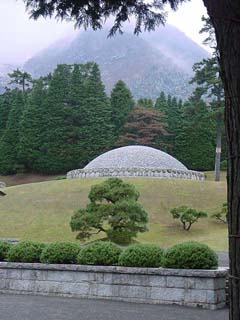

------------------------------- ### -------------------------------
O texto abaixo reproduz na Ýntegra e sem comentßrios, o folheto explicativo distribuÝdo em Hakone no mausolÚo de Meishu Sama, datado e assinado. Alterei apenas onde aparecia "Mokichi Okada" ou simplesmente "Okada", que substituÝ por "Meishu Sama".
------------------------------- ### -------------------------------
"Okutsuki, the Mausoleum of Meishu Sama
Meishu Sama was born in Tokyo on December 23, 1882. During the early years of adulthood, he was a successful businessman. When, at the age of 44, he learned of his divine mission through a revelation, he relinquished his business interests to his employees and devoted the rest of his life to the creation of an ideal world.
Meishu Sama provided the basic concept and detailed plans for the creation of the world of true civilization. He commenced work on the construction of a prototype of Paradise on Earth, wich would form the core of that concept. In 1944, Meishu Sama moved to Gora, Hakone. There he began work on the construction of Kanzantei, the centerpiece of the prototype Shinsenky˘. Kanzantei was completed on June 15, 1953.
The prototype Shinsenky˘ was completed in 30 years, the limited but precious duration of Meishu Sama's divine mission, for wich he was brought to us - promulgation of the Divine Plan for the creation of an ideal world. Meishu Sama hastened to complete construction work on other prototypes, Zuiunky˘ in Atami and Heyanky˘ in Kyoto. Unfortunately, Meishu Sama never saw the completed prototypes, since his mission on this earth ended when he was 73 years old, on February 10, 1955.
At Kanzantei, Meishu Sama demonstrated the basic concept for the creation of the true civilization, and created its foundation. His spiritual residence is the K˘my˘ Sanctuary, from whence he oversees the advancement of the World Divine Plan. His body has been laid to rest here at the Okutsuki Mausuleum.
During his sojourn on Earth, Meishu Sama stated that the grave unites the physical world with the spiritual world. Thus, the Okutsuki Mausoleum connects those of us who dwell in the physical world, the members of T˘h˘-no-Hikari and MOA, with Meishu Sama, who resides in the spiritual world.
Okutsuki is situated directly between Mount Kamiyama wich, as Meishu Sama instructed, is the center of the world, and his prototype, Shinsenky˘. He designated the place as His eternal residence. Meishu Sama taught us that every site fulfills its own particular role. We have taken his words to heart, and constructed his mausoleum at this most fitting, sacred place.
When we set out to construct this mausoleum, we encountered formidable obstacles. This is a government-designated scenic area, and is therefore subject to many restrictions. However, the authorities acceded to the fervent desire of Meishu Sama's followers to honor His instructions, and the mausoleum was completed.
Previously, the site was a densely wooded area, but 2.000 truckloads of soil were brought in, and 1.200 volunteers and 555 professionals set to work. The construction of the Okutsuki Mausoleum was completed after only three days and nights of work in the bitter cold.
Since May of 1989, our organization has undergone a series of radical reforms. One of them was elevation of Meishu Sama's divine name from Oshiemioyanushi-no-kami to Meishu-no-mikami, the Savior of the world and the most exalted of deities.
Shinsenky˘, the prototype of Paradise on Earth, has also been revitalized in accordance with Meishu Sama's wishes.
After Meishu Sama departed from his Earth, our organization purchased adjoining parcels of land in succession. Consequently, the sacred grounds in the vicinity of Okutsuki are united directly with the sacred groundsof Shinsenky˘, wich is located immediately below Okutsuki.
Okutsuki was completed immediately after Meishu Sama's passing. However, due to the subsequent expansion of the sacred grounds, we have embarked on a major renovation project. Our goal is to make Okutsuki a place that is in keeping with the spirituality of the Savior, Meishu-no-mikami, and the center of our sacred grounds.
The renovation work commenced in autumn of 1997, and was completed on the auspicious occasion of the K˘my˘ Service, thanks to the unstinting efforts of all those involved.
Next to Meishu Sama's grave is the grave of His wife, Yoshi, His wife and lifelong companion.
February 10, 1998 T˘ho-no-Hikari . MOA International"